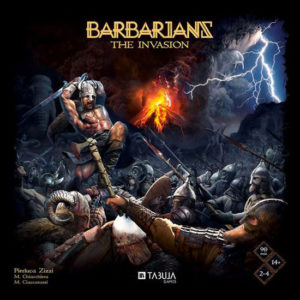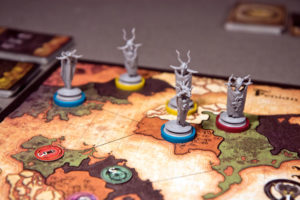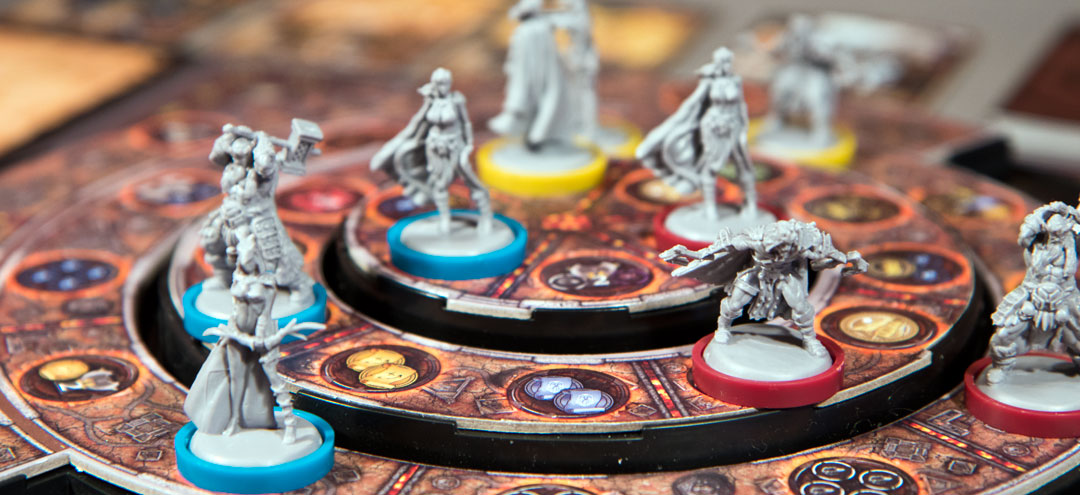 When I hear a name like Barbarians: The Invasion, clearly the first thing I’m going to think of is a solid eurogame. OK, maybe not, but that didn’t stop the designers at Tabula Games from using a horde of invading barbarians for the theme in their newest game. While not wholly unique, I do love to see publishers branching out into more diverse themes.
When I hear a name like Barbarians: The Invasion, clearly the first thing I’m going to think of is a solid eurogame. OK, maybe not, but that didn’t stop the designers at Tabula Games from using a horde of invading barbarians for the theme in their newest game. While not wholly unique, I do love to see publishers branching out into more diverse themes.
Barbarians: The Invasion is a worker placement, resource management, and area control game for 2 to 4 players that takes about 90 minutes to play. The game plays best with three players.
Gameplay Overview:
The goal in Barbarians: The Invasion is to earn the most domination points (victory points) for your clan. Players will earn these in a variety of ways over the course of the games six rounds.
Each round is broken up in three phases: Maintenance, Action, and End of Era, with the action phase being where the majority of the game happens. Each player has 3 champions that they will use to claim spaces during the round using familiar worker placement mechanics.
Unique to Barbarians: The Invasion is that the placement spots are on a “volcano”. A player’s first champion must be placed on one of the six spots in the top ring. The second champion must then be placed on the second ring in an area connected to the first champions spot (and so on with the 3rd champion). Different action spots include gaining resources (5 different types), purchasing God, Chieftain or Building cards, researching new technology or going to war.

When a player goes to war, they choose an accessible, unclaimed area on the map to attack. They may then pay resources to recruit as many of the three different troops as they can afford. For the actual war, it uses a light “press your luck style” mechanic. You draw a number of cards (1-6 based on your tactics level) and must spend the troops listed on the card to win the battle. If you can’t or don’t spend the troops, you fail that battle and suffer the penalties. You must win half the battles to win the war and claim the territory.
In addition to the tactics technology, there are also tracks for knowledge that will let you reach distant islands to wage war, avoid penalties in battles, gain bonus resources, or activate buildings during the maintenance phase. The first and second player to reach the end of each tech track earns a bonus.
At the end of each round, players must resolve a feast card or a demon. These usually require spending resources or cards for bonuses. As all of these cards are face up, players can plan ahead.
At the end of the sixth round, the game ends. After some quick final scoring, the player with the most domination points wins.

Game Experience:
Barbarians: The Invasion is one of those games where you feel like you have a lot to explain to a new player. You need to go over the different areas of the board, how each of the tracks work, and the worker placement spaces. It can be a lot to take in at the start. Yet despite all that’s going on in the game, it’s actually not that complicated. After a round or so, most players get a solid feel for what each of the areas do and turns should go by smoothly. However I do wish the game included a player aid for each player, as it would make learning the worker placement spots easier.

Despite the learning curve, having all these different areas in the game is something I really enjoyed. Barbarians: The Invasion is one of those games where you will constantly feel like you just need more time. With only three actions in a round, it’s impossible to focus on every area. Do you spend your time going to war? Or perhaps you focus on acquiring buildings for resources and end game scoring? You also can’t neglect the technology tracks and the important bonuses they grant. If you enjoy games where you constantly have to shift your attention, then you will have fun with Barbarians: The Invasion.
And it’s all this content, and there is a lot of it, that helps to give Barbarians: The Invasion a ton of replay value. In fact, the copy we were provided for this review also includes a built in expansion that has extra invasion maps, new rules, and even an alternate set of worker placement spots. I can easily say that there is plenty in this box to keep you entertained for a long time.

One of the most unique things about the game has to be the worker placement spaces. A set of three rings hold the spaces, and players will need to plan their turns in advance as your initial placement will dictate what you have access to for your second and third champions. And just to throw a wrench into your plans, god cards can also be used to rotate the Volcano rings. So if you get locked out of a spot you want to go to, you still have the ability to manipulate the board to get where you need to be.
One issue that arose was that the god cards didn’t feel wholly balanced. Some definitely feel more powerful than others. That’s not a huge issue, as anyone can buy them during the game, except for the setup. Each player is dealt a random god card at the start of the game. If you get the one that lets you rotate the volcano twice, and you opponent has one that gives them a free honor point every round (honor determines turn order and other bonuses), that’s not going to feel very fair. I do wish the publisher would have just created 4 starting gods and had the players being with those.

Final Thoughts:
Other than my issue about the balancing of the god cards, I don’t have much to complain about with Barbarians: The Invasion. It’s a medium weight euro game that blends together a lot of familiar mechanics: worker placement, area control, resource management and even a little bit of engine building. While the game can be a table hog, there is so much content in the box that I don’t foresee any complaints about the replay value. I definitely enjoyed Barbarians: The Invasion and even after quite a few plays I’m looking forward to trying out all the included expansions. This was the first game I’ve played from Tabula Games and I’m definitely going to keep my eye out for their future offerings.
Final Score: 4 Stars – A great euro game that blends a lot of familiar mechanics into a strong ruleset with a fun theme.
 Hits:
Hits:
• Enjoyed the volcano worker placement mechanics
• Loads to do during the game
• Massive amount of replay value
• Great production values
Misses:
• God cards don’t feel totally balanced
• Player aids would help the learning curve






















